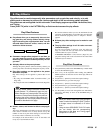
2
The Pattern Mode
3. Phrase Recording
RS7000 83
Operation when the [OCT DOWN] key is held is the
opposite: the high E key enters ±0000, and each key to
the left of this lowers the value by ±341 until -8192 is
reached at the leftmost white key.
When the keyboard only is used, the SECTION H (middle
C) white key corresponds to ±0000, while each semitone
to the right of this key adds approximately 341, and each
semitone to the left subtracts the same amount. The sec-
ond white key from the right produces a value of +4096,
and the leftmost white key produces a value of -4096.
When the EVENT TYPE is CC
The control change values from 000 through 127 are
assigned to the keyboard.
The leftmost white key (E) enters 000, and each key to the
right increases the value by 5 or 6 until 127 is reached at
the high E key (the second from rightmost white key).
Like step recording, grid step recording allows notes to be
recorded to a user phrase one at a time. With grid step recording,
however, the pitch of the notes to be entered is specified first, and
the data-entry position is specified via the keyboard. This method
is particularly useful for entering drum patterns or sequences
which use several consecutive notes of the same pitch.
Record Procedure
1. Press [PATTERN] to enter the PATTERN Play mode.
2. Specify a style and section to select the pattern for which the
phrase is to be recorded (Page 72).
3. Press [PATTERN] to switch to the PATTERN Patch mode.
4. Select a track and a user phrase (Page 75).
5. Press [REC] to engage the Rec Standby mode (PATTERN
Patch).
6. Use [Knob 1](BANK) and [Knob 2](PGM) to select a voice
for the phrase. If necessary use [Knob 3](TRANS ON/OFF)
to turn transposition ON or OFF.
7. Press [PATTERN] to switch to the PATTERN Play Rec
Standby mode.
8. Use [Knob 2] to select the GRID record type.
9. Press [PLAY] and the Grid Step record display will appear.
10. Set the pitch of the notes to be entered via [Knob 1](NOTE).
If necessary also use [Knob 2](GATE TIME) to set the gate
time and [Knob 3](VELOCITY) to set the note velocity.
11. Use the keyboard to specify the note-entry point on the grid.
The grid divides a measure into 16
th
note divisions, and the
16 white keys on the keyboard correspond to each of these
grid positions.
The leftmost white key enters a note on the first beat of the
measure, the 5
th
white key (B) enters a note right on the 2
nd
beat, and so on.
A note is entered on the grid each time a white key is pressed
and its indicator lights. Press the same white key a second
time so that its indicator goes out to erase the note at that
position.
1 2 3 4 5 6 7 8 9 10 11 12 13 14 15 16
K ! L # M $ N % O & P ' Q ( R ) S - T @ U ^ V _ W { X } Y ~ Z
ALL TR- TR+
PAD ASSIGN
1~8 9~16
ABC DE FGH IJ
TAP
OCT
DOWN
OCT
UP
±0000 +8191
Each semitone increases the value by 341
Hold
1 2 3 4 5 6 7 8 9 10 11 12 13 14 15 16
K ! L # M $ N % O & P ' Q ( R ) S - T @ U ^ V _ W { X } Y ~ Z
ALL TR- TR+
PAD ASSIGN
1~8 9~16
ABC DE FGH IJ
TAP
OCT
DOWN
OCT
UP
-8192 ±0000
Hold
Each semitone decreases the value by 341.
1 2 3 4 5 6 7 8 9 10 11 12 13 14 15 16
K ! L # M $ N % O & P ' Q ( R ) S - T @ U ^ V _ W { X } Y ~ Z
ALL TR- TR+
PAD ASSIGN
1~8 9~16
ABC DE FGH IJ
TAP
-4096 +4096±0000
Each semitone
increases the value
by 341
Each semitone
decreases the value
by 341
Grid Step Recording
1 2 3 4 5 6 7 8 9 10 11 12 13 14 15 16
K ! L # M $ N % O & P ' Q ( R ) S - T @ U ^ V _ W { X } Y ~ Z
ALL TR- TR+
PAD ASSIGN
1~8 9~16
ABC DE FGH IJ
TAP
000 127
Increases by 5 or 6 with each semitone.


















